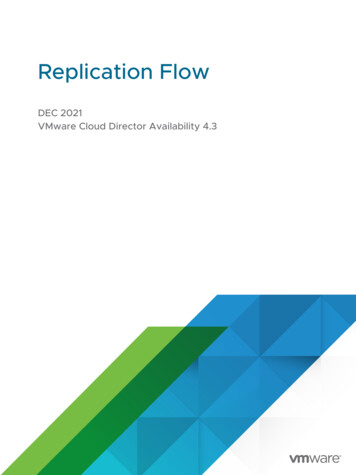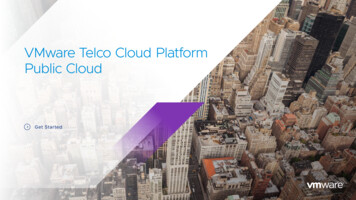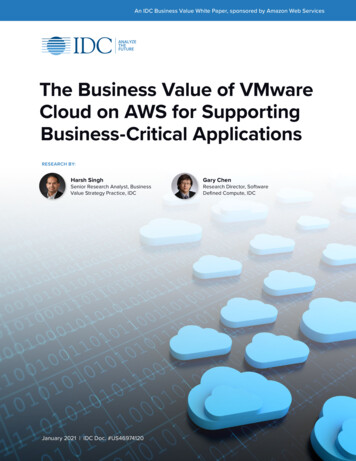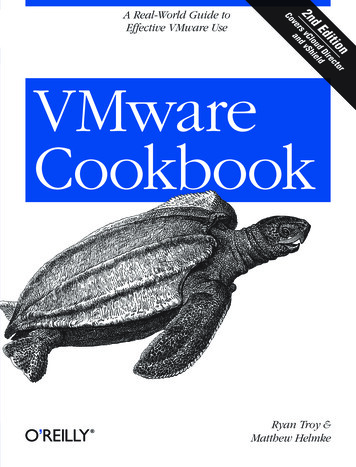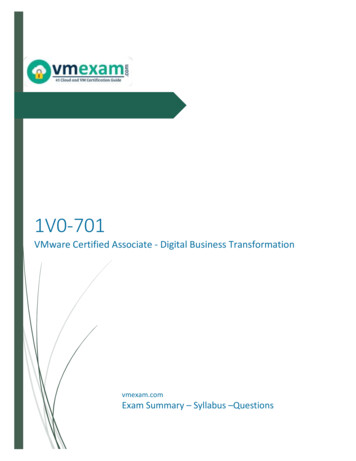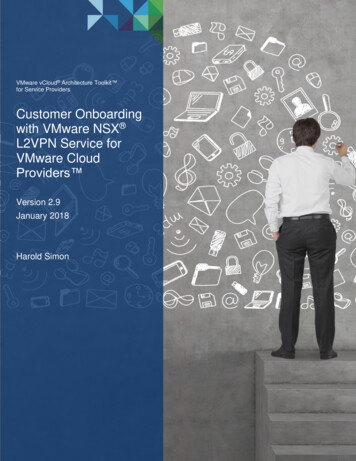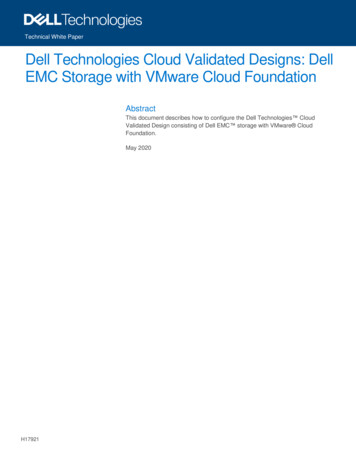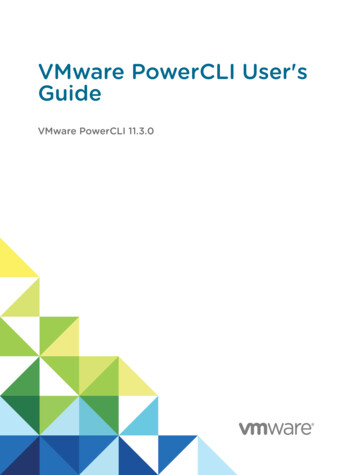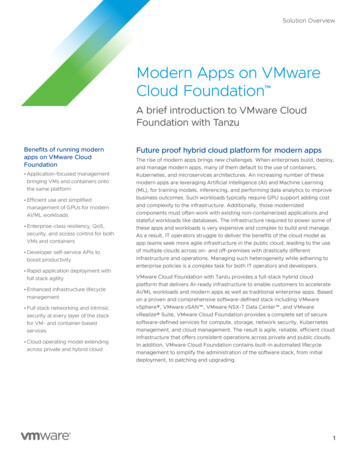
Transcription
Solution OverviewModern Apps on VMwareCloud Foundation A brief introduction to VMware CloudFoundation with TanzuBenefits of running modernapps on VMware CloudFoundation Application-focused managementbringing VMs and containers ontothe same platform Efficient use and simplifiedmanagement of GPUs for modernAI/ML workloads Enterprise-class resiliency, QoS,security, and access control for bothVMs and containers Developer self-service APIs toboost productivity Rapid application deployment withfull stack agility Enhanced infrastructure lifecyclemanagement Full stack networking and intrinsicsecurity at every layer of the stackfor VM- and container-basedservices Cloud operating model extendingacross private and hybrid cloudFuture proof hybrid cloud platform for modern appsThe rise of modern apps brings new challenges. When enterprises build, deploy,and manage modern apps, many of them default to the use of containers,Kubernetes, and microservices architectures. An increasing number of thesemodern apps are leveraging Artificial Intelligence (AI) and Machine Learning(ML), for training models, inferencing, and performing data analytics to improvebusiness outcomes. Such workloads typically require GPU support adding costand complexity to the infrastructure. Additionally, those modernizedcomponents must often work with existing non-containerized applications andstateful workloads like databases. The infrastructure required to power some ofthese apps and workloads is very expensive and complex to build and manage.As a result, IT operators struggle to deliver the benefits of the cloud model asapp teams seek more agile infrastructure in the public cloud, leading to the useof multiple clouds across on- and off-premises with drastically differentinfrastructure and operations. Managing such heterogeneity while adhering toenterprise policies is a complex task for both IT operators and developers.VMware Cloud Foundation with Tanzu provides a full-stack hybrid cloudplatform that delivers AI-ready infrastructure to enable customers to accelerateAI/ML workloads and modern apps as well as traditional enterprise apps. Basedon a proven and comprehensive software-defined stack including VMwarevSphere , VMware vSAN , VMware NSX-T Data Center , and VMwarevRealize Suite, VMware Cloud Foundation provides a complete set of securesoftware-defined services for compute, storage, network security, Kubernetesmanagement, and cloud management. The result is agile, reliable, efficient cloudinfrastructure that offers consistent operations across private and public clouds.In addition, VMware Cloud Foundation contains built-in automated lifecyclemanagement to simplify the administration of the software stack, from initialdeployment, to patching and upgrading.1
Modern Apps on VMware Cloud Foundation Key benefitsDeveloper self-service APIs to boost productivityMany IT organizations rely on slow ticketing systems to provideinfrastructure services to developers because it is the only way toprovide governance over developer applications and processes.VMware Cloud Foundation provides a self-service private cloud,enabling the ability to manage at the namespace level so that adminscan set policies, quota, and role-based access to a namespace once.Developers can then self-service into the namespace within thepredefined boundary.With Kubernetes embedded into the control plane of vSphere,developers can create and consume cloud resources such asKubernetes clusters, volumes (including persistent volumes for statefulapplications), and networks with VMware Cloud Foundation Services(Figure 1) using Kubernetes and RESTful APIs that they are familiar with.This reduces the time and effort it takes for infrastructure provisioningand scaling so that developers can focus on building apps. Meanwhile,IT operators maintain visibility into those cloud resources created bydevelopers through the VMware interfaces that they are familiar with.Figure 1: VMware Cloud Foundation Solution ArchitectureApplication-focused management bringing VMs andcontainers onto the same platformWith VMware Cloud Foundation, customers get unified visibility ofvirtual machines (VMs), containers, and Kubernetes clusters in vCenter.Containers and Kubernetes clusters are treated as first-class citizens likeVMs from a vCenter perspective.The Kubernetes concept of a namespace is integrated into vSphere andbecomes the unit of management. By grouping resource objects such asVMs and containers into logical applications via namespaces, VirtualInfrastructure (VI) admins who previously managed thousands of VMscan now manage just dozens of application namespaces, resulting in amassive increase in scale and reduction in cognitive load.Solution Overview 2
Modern Apps on VMware Cloud FoundationEnterprise-class resiliency, QoS, security, and access control for bothVMs and containersAll policies to optimize for performance, resilience and availability thathave been available to VMs are also available to containers andKubernetes clusters. Admins can define QoS, security policies, firewallrules, encryption settings, availability and backup rules, and accesscontrol rules at namespace level, reducing the time it takes to manageand troubleshoot applications.NSX-T has been designed as the pod networking for VMware CloudFoundation with Tanzu. NSX-T provides the full stack networking andsecurity to vSphere with Kubernetes including distributed switching androuting, distributed firewalling, load balancing, ingress control andmore. Integrations with Kubernetes enables context-aware securitypolicies with namespace isolation.Rapid application deployment with full stack agilityIn VMware Cloud Foundation, a workload domain is a policy-basedresource construct with specific availability and performance attributes.It combines compute (vSphere), storage (vSAN), networking (NSX-T),and cloud management (vRealize Suite) into a single consumable entity.Workload domains greatly speed up the instantiation of Kubernetes,deploying both the underlying infrastructure and Kubernetescomponents in an automated fashion. Workload domains also allow IToperators and developers to securely sandbox and allocate the rightinfrastructure for containers alongside VMs. For example, a customercan have a workload domain with Kubernetes clusters for a modernapp, and another workload domain for databases or VDI apps, whichhave different infrastructure requirements.Enhanced infrastructure lifecycle managementVMware Cloud Foundation offers automated lifecycle management on aper-workload domain basis. Available updates for all components aretested for interoperability and bundled with the necessary logic forproper installation order. The update bundles are then scheduled forautomatic installation on a per-workload domain basis. This allows theadmin to target specific workloads or environments (development vs.production, for example) for updates independent from the rest of theenvironment.Solution Overview 3
Modern Apps on VMware Cloud Foundation Full stack networking and intrinsic security at every layer of the stackAt the container image layer, Tanzu Kubernetes Grid includes a best-inclass container registry with built-in vulnerability scanning, imagesigning, and auditing.At the compute layer, vSphere provides comprehensive built-in securityfor protecting data, infrastructure, and access that is operationallysimple. Policy-driven security provides VM- or pod-level encryption toprotect unauthorized data access both at rest and in motion.At the network layer, NSX-T delivers micro-segmentation and granularsecurity to the individual VM or pod workload, enabling a fundamentallymore secure data center. Security policies travel with the workloads,independent of where workloads are in the network topology.At the storage layer, vSAN offers data at rest and data in transitencryption at the cluster level. Storage Encryption is built for compliancerequirements and offers simple key management with support for allKey Management Interoperability Protocol (KMIP) compliant keymanagers.At the management layer, vRealize solutions automate manual tasks toeliminate human error, provide monitoring and auditing the full stack,and provide self-driving operations to quickly remediate issues as theyare identified.Cloud operating model extending across private and hybrid cloudThe same core software-defined infrastructure stack leveraged inprivate cloud deployments of VMware Cloud Foundation is also theunderpinning technology of VMware based public clouds like VMwareCloud on AWS and other VMware Cloud Provider Program partners,as well as VMware Cloud on Dell EMC. With VMware Cloud Foundationpowered clouds offering consistent infrastructure and operations,customers can begin to shift to a different way of operating IT, whereservice delivery is better aligned to the service consumption needs ofthe business. Adopting a cloud operating model represents a movetoward application modernization and new application architectures thatenable digital initiatives.Solution Overview 4
Modern Apps on VMware Cloud Foundation Resources Learn more about VMware CloudFoundation on the website Check out Cloud Foundation Blog,Twitter, and YouTube for the latestupdates on Cloud Foundation Want to try Cloud Foundation foryourself? Visit the VMware CloudFoundation Hands-On LabEfficient use and simplified management of GPUs for AI/ML workloadsAI/ML workloads are gaining mainstream enterprise adoption asorganizations adopt new data driven business models to gaincompetitive advantage in their markets. These workloads can helpimprove customer experience as well as increase operational efficiency.Typically involving training models, inferencing and data analytics, all ofwhich are compute intensive, these workloads typically require GPUsupport and its efficient utilization to reduce costs.VMware Cloud Foundation with Tanzu now supports the latest NVIDIAAmpere GPUs. By virtualizing GPUs and with multi-instancemanagement support, these GPUs can be shared across multipleinstances to deliver that increased optimization of resources andreduced costs. IT admins can quickly and easily provision self-servecapabilities to Data scientist and DevOps teams when building AI/MLdata pipelines using these vGPUs with VMware Cloud Foundation andthe NVIDIA AI Enterprise Suite (Figure 2) to address the issue ofAI-ReadyEnterprisePlatformof these resources.complexityof managementData Center AI Trainingand InferenceEdge AIInferenceData Analytics andMachine LearningNVIDIA AI EnterpriseAI and Data Science Tools andFrameworksData ScientistDeveloperAI ResearcherCloud-Native DeploymentContainersOn-Demand KubernetesClusters and Virtual MachinesInfrastructure OptimizationVirtual MachinesIntrinsic Security andLifecycle Management80Live Migration and LoadBalancingVMware Cloud FoundationWith TanzuManagementStorageComputeNetworkingIT AdminAccelerated Mainstream ServersNVIDIA GPUNVIDIA SmartNIC / DPU*Application AccelerationNetwork and Infrastructure AccelerationEdgeConfidential 2022 VMware, Inc.Hybrid CloudPrivate Cloud* Future capability not available with VCF 4.4Figure 2: VMware Cloud Foundation AI Ready Enterprise PlatformVMware Cloud Foundation takeaways Easy to deploy and run integrated cloud infrastructure, including compute,storage, networking, security, and cloud management services for modernapplications on the same platform as for traditional applications. Boosts developer productivity, allowing app teams to access cloud resourcesthey are already familiar with through industry standard APIs. Simple to operate and future proof hybrid cloud strategy that is consistentand compatible across on- and off-premises environments with the ability todeploy VMs, containers, and any next-generation application needs.Copyright 2022 VMware, Inc. All rights reserved. VMware, Inc. 3401 Hillview Avenue Palo Alto CA 94304 USA Tel 877-486-9273 Fax 650-427-5001VMware and the VMware logo are registered trademarks or trademarks of VMware, Inc. and its subsidiaries in the United States and other jurisdictions. All other marks and namesmentioned herein may be trademarks of their respective companies. VMware products are covered by one or more patents listed at vmware.com/go/patents.Item No: Modern Apps on VMware Cloud Foundation - Solution Brief 2/221
on a proven and comprehensive software-defined stack including VMware vSphere , VMware vSAN , VMware NSX-T Data Center , and VMware vRealize Suite, VMware Cloud Foundation provides a complete set of secure software-defined services for compute, storage, network security, Kubernetes management, and cloud management.


